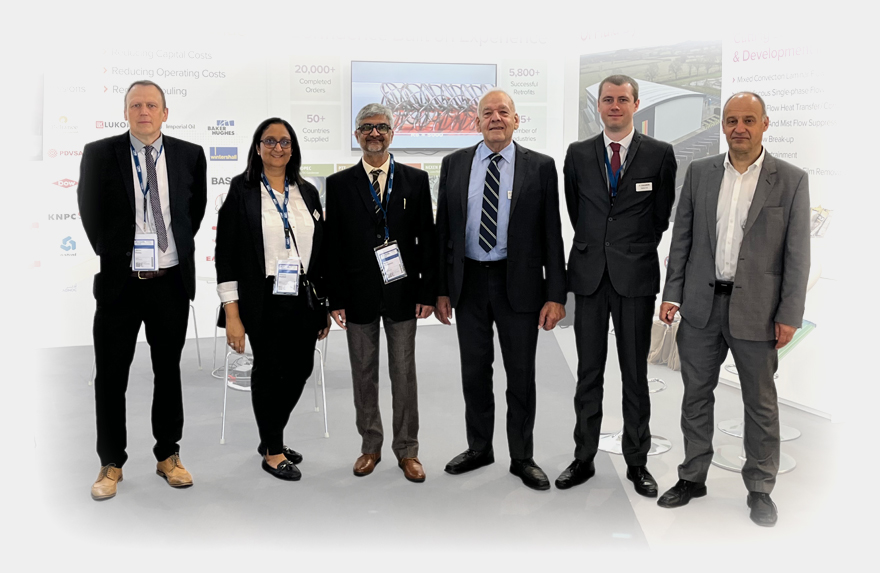Webinar Abstracts
We are proud to have broadcast a very well-received range of heat transfer related webinars since 2016
Internal Condensers for Distillation Columns
Presented by Ian Gibbard
Panelist: Peter Ellerby - Engineering Manager
In this session, the challenges involved in the design of internal distillation column condensers will be addressed. Internal condensers have a number of advantages compared to external types, but also present numerous design challenges. This webinar will describe the most common types and compare their characteristics in typical applications.
Placing a condenser at the top of a distillation column presents some practical problems, and positioning the condenser inside the column complicates things still further. Nevertheless, the advantages of the internal arrangement can be significant for some processes and this motivates designers to find solutions. In some cases heat transfer enhancement plays a crucial role and this will be discussed in the webinar.

Quick and Easy Retrofits for Energy Saving
Presented by Ian Gibbard
Panelist: Peter Ellerby - Engineering Manager
The rising cost of energy and CO2 emissions motivates a search for energy-saving opportunities in process plants. Projects which minimise plant downtime and structural modifications are obviously attractive, and the application of heat exchanger enhancement fits this requirement perfectly by optimising existing heat exchanger assets.
There are numerous ways in which heat exchangers influence plant energy consumption. Where a heat exchanger is in heat recovery service direct energy savings are possible. For other heat exchangers the energy savings may be achieved indirectly and these opportunities are more challenging to identify.
This webinar will examine several different energy saving strategies which can be delivered through quick and easy heat exchanger retrofits. Case studies will be presented to illustrate the practical nature of the opportunities available.

Twisted Tape: A 19th Century product in a 21st Century World
Presented by Ian Gibbard
Panelist: Dr Peter Drögemüller - R&D Manager
Tubular heat exchangers had hardly been invented before engineers placed twisted metal strips inside their tubes to improve performance. Such "retarders" were in common use in the 19th century, fitted to the fire tubes of steam boilers.
In the last 150 years many researchers have studied the effect of twisted tapes on fluid flow and heat transfer, publishing thousands of technical papers on the subject. These devices remain in use today, despite the availability of more efficient alternatives. This webinar will examine the reasons for the continued popularity of twisted tapes for heat exchanger enhancement. The current status of performance characterisation and manufacturing technology will be discussed, defining the typical limits of application. The benefits of a comprehensive product specification will be identified, suitable for the demands of 21st century manufacturing.

Multi Component Condensers
Presented by Ian Gibbard
Panelist: Peter Ellerby - Engineering Manager
In this session, the challenges involved in the design of multi-component condensers will be addressed. Condensers convert vapours into liquids using a coolant. Where the vapour is a multi-component mixture, this process is relatively complex and requires careful heat exchanger design. Various heat exchanger types are used in condensing service, and this webinar will describe the most common types and compare their characteristics in typical applications.
The thermal design of condensers can be complex and challenging but should not be problematic as long as some basic principles are understood. The webinar will examine the range of factors which must be considered in order to develop practical condenser designs which provide reliable operation. The role of heat transfer enhancement in condenser design will also be considered.

Distillation Column Reboilers
Presented by Ian Gibbard
Panelist: Peter Ellerby - Engineering Manager
In this session, the challenges involved in the design of distillation column reboilers will be addressed. Reboilers provide heat input to the distillation process, generating vapour which travels up the column. Various heat exchanger types are used in reboiler service, and this webinar will describe the most common types and compare their characteristics in typical applications.
The thermal design of reboilers can be complex and challenging but should not be problematic as long as some basic principles are understood. The webinar will examine the range of factors which must be considered in order to develop reliable reboiler designs. The role of heat transfer enhancement in reboiler design will also be considered.

hiTRAN® Thermal Systems in fouling applications
Presented by Dr Peter Drögemüller
In this webinar we will demonstrate how hiTRAN® Thermal Systems can be used as a tool to affect the fouling behaviour inside tubes. Fouling characteristics and mechanisms are influenced largely by the properties of the thermal and hydrodynamic boundary layer. The main driving force for the use of hiTRAN. Elements in heat exchanger design is the substantial increase achieved in tube side heat transfer performance. As a direct consequence the resulting tube wall temperature is altered. Another important aspect is an increase in wall shear forces when applying this insert type.

CFD & Single Phase Maldistribution in Heat Exchangers
Presented by Peter Ellerby & Will Osley
This session is a follow on from the previous webinar about single phase maldistribution in heat exchangers. Some of the issues raised relating to shell and tube exchangers will be looked at in greater detail by focusing on a single example. In particular, the cause of poor distribution will be investigated, looking at the effect of certain geometry options. The effect of distribution on performance will be investigated, and options for improving distribution will be assessed. As an integral part of the presentation, CFD will be used to analyse and illustrate the distribution.

Improved Economics & Plant Operability by Enhancing Heat Exchanger Performance
Presented by Martin Gough
De-bottlenecking activities where operators of plants can process more product through units within the same plot space and existing heat exchangers, save both capital and operating costs, improving plant economics with short payback times. Secondly, an equally important benefit gained from improved heat exchanger performance is reduced energy consumption when heating or cooling of process streams contributing to greener production.
Examples of retrofits and the corresponding detailed analysis will be shown, supported by the focussed research behind CALGAVIN’s products and process warranties.

Single Phase Flow Maldistribution in Heat Exchangers
Presented by Ian Gibbard
In this session, the challenges dealing with single phase maldistribution in heat exchangers will be investigated. The topics covered include the general effects of maldistribution (heat transfer coefficient, temperature driving force, fouling etc.), manifold maldistribution, the effect of maldistribution by exchanger type (ACHE, STHE and PFHE) and common problems and their solutions.

Heat Exchanger Reactors
Presented by Ian Gibbard
Panelist: Dr Peter Drögemüller - R&D Manager
In this session the challenges involved in the design of heat exchanger reactors will be addressed. Simultaneous heat transfer and chemical reaction is often desirable when the reaction is exothermic, in order to maintain the optimal temperature of the reaction mixture. However, designing a heat exchanger for chemical reaction service is far more complex than for heat transfer alone. The webinar will identify the additional factors to be considered and discuss some potential solutions.

A Comparison of hiTRAN® Thermal Systems and Twisted Tapes
Presented by Peter Ellerby
hiTRAN Thermal Systems and Twisted Tapes are both tube side established heat transfer enhancement devices, which are often specified for similar services. This webinar will look at each device’s geometry and how it produces its enhancement effect.
From this fundamental understanding, and a comparison of performance data, the results from the application of this data in practical cases, across a range of flow regimes, will follow.
From the explanations in the case studies, we will answer the question of which type is most suitable for selected flow regimes or applications, and discuss the practical differences relating to the installation of the chosen device type.

Heat Exchangers for Batch Reactors
Presented by Ian Gibbard
Panelist: Tom Higley - Sales & Business Development Manager
In this session, the challenges involved in the heating and cooling of batch reactors will be explained. Most reactors require the facility to add and/or remove heat during the batch cycle, and the more efficiently this can be achieved the better.
External jackets or internal coils may be sufficient for small reactors or modest heat loads, but in many cases, an external heat exchanger will be required. Although such heat exchangers are relatively simple, the geometric constraints placed on the layout can make their design challenging. An example will be used to demonstrate how effective design can be achieved.

Using the Power of CFD to Solve Engineering Problems
Presented by William Osley
We will be covering the following topics in this webinar. First, we will look at an overview of how CFD works, where we have used it and what information you can get out of it. Then we will look at a CFD investigate we carried out into Air Cooled heat exchangers.
And finally, a case study about an underperforming ACHE that builds on the observations we found from our ACHE investigation.

hiTRAN® Thermal Systems in tube side condensing processes
Presented by Dr Peter Drögemüller
In this webinar, we explain in detail the changes in hydrodynamic in vertical and also horizontal condensers when applying hiTRAN. With the use of flow maps we will show in detail how the flow and therefore also the heat and mass transfer is altered when use hiTRAN technology. During the webinar we will give guidelines which variables are important to determine whether hiTRAN installation will be beneficial. Industrial case studies are presented where hiTRAN Thermal Systems was used to increase the performance.

Advanced Software Tools to Capture Heat Exchanger Cost Savings
Presented by Nathan Hill
In this webinar, we will discuss the process of designing of a heat exchanger to use heat transfer enhancement technology.
We will then look at the estimation and comparison of the costs between a normal & enhanced design to justify considering enhancement.

hiTRAN®.SP Software Integration in HTRI Xchanger Suite®
Presented by Dr Peter Drögemüller
In this webinar the integration from our hiTRAN.SP software into HTRI Xchanger Suite is demonstrated. We will show how to identify suitable applications for hiTRAN Thermal Systems using the hiTRAN optimisation panel. Starting from an empty tube design we will be demonstrating, step by step, how the exchanger size can be reduced using hiTRAN enhancement. It is also shown in a HTRI / hiTRAN.SP case study how the technology can be used to retrofit existing exchangers to improve the performance. The difference between hiTRAN insert optimisation in rating mode and simulation calculations are explained.

Boiling with a Low Delta T
Presented by Ian Gibbard
Panelist: Dr Peter Drögemüller - R&D Manager
In this webinar, the challenges involved in boiling fluids at low temperature driving forces will be addressed. Boiling heat transfer is complex and strongly affected by the temperature of the heat transfer surface. Opportunities exist to use enhancement to obtain efficient and reliable heat exchanger designs.
The webinar will define the problem, discuss possible solutions and use examples to compare the results of the various strategies available.

Total Vaporisation
Presented by Ian Gibbard
Panelists: Peter Ellerby - Engineering Manager & Dr Peter Drögemüller - R&D Manager
In this webinar, the challenges involved in the design of vaporisers will be addressed. A vaporiser is typically required to take a sub-cooled liquid feed and covert it to a superheated vapour. There are a number of potential difficulties associated with such a process, and many heat exchangers of this type fail to perform as expected. The webinar will define the problem, discuss possible solutions and use examples to compare the results of the various strategies available.

Heat Recovery
Presented by Ian Gibbard
Panelists: Peter Ellerby - Engineerting Manager & Tom Higley - Sales & Business Development Manager
In this webinar the challenges involved in the design of heat exchangers for heat recovery duties will be addressed. Many processes depend on heat recovery to minimise fuel consumption and therefore be competitive. The successful design of heat exchangers for heat recovery duties requires the effective use of the available temperature and pressure driving forces, which must be balanced against practical issues such as mechanical design and maintenance. The webinar will define the problem, discuss possible solutions and use examples to compare the results of the various strategies available.

Cooling Near a Pour Point
Presented by Ian Gibbard
Panelist: Peter Ellerby - Engineering Manager
In this webinar the challenges involved in the cooling of liquids near to their pour points will be addressed. This issue typically arises when cooling hydrocarbon mixtures containing high-molecular weight components. If the mixture is cooled too aggressively, solid material may form on the heat transfer surface and the flow resistance will increase significantly. Flow through the heat exchanger may cease altogether. In order to avoid operational difficulties, heat exchangers must be specifically designed to address this issue. The webinar will define the problem, discuss possible solutions and use examples to compare the results of the various strategies available.

Cooling Viscous Liquids
Presented by Ian Gibbard
Panelist: Peter Ellerby - Engineering Manager
The challenges involved in the cooling of viscous liquids will be addressed. Achieving turbulent flow is unrealistic with fluids of even moderate viscosity, and this leads to a range of practical problems in heat exchanger design. Where the viscous fluid is being cooled these challenges are particularly difficult.
The webinar will examine these limitations and evaluate the various strategies available to overcome them. Practical examples will be used to compare the effectiveness of these strategies for typical applications.

hiTRAN® Heat Transfer Enhancement in Single Phase Flow
Presented by Dr Peter Drögemüller
In this webinar we will explain how hiTRAN Thermal Systems changes the hydrodynamics in tube flow. This is demonstrated using dye stream and sophisticated laser measurement techniques. The change in hydrodynamic has profound implications on the tube side heat transfer. Especially in laminar flow double figure increases in tube side heat transfer are possible. Measured data and CFD simulations are used to back up the findings.
During the webinar we will explain how to design hiTRAN enhanced exchangers without pressure drop penalty, but much increased heat transfer.

Part 2: Principles of Single Phase Heat Transfer in Round Tubes: Applications and Flow Maps
Presented by Dr Peter Drögemüller
In part one of this webinar topic we discussed the fundamentals of single phase heat transfer in round tubes, with focus on laminar flow. In the upcoming webinar we want to apply this knowledge to discuss different case studies. The case studies will reflect exchangers operating in forced or mixed convection regime. Laminar flow conditions evaluated will range from high viscous polymer exchanger in forced convection flow to slow flowing low viscous fluids in temperature cross situations. Using flow maps, the characteristics are identified and explained with the help of CFD simulations. We will also discuss different reasons, which drives the heat exchanger design towards laminar fluid allocations on the tube side.

Principles of Single Phase Heat Transfer in Round Tubes
Presented by Dr Peter Drögemüller
This webinar will cover the different mechanism of single phase heat transfer associated with the different flow regimes inside round tubes. The discussion will focus on heat transfer in laminar and transitional flow, which can be governed by forced or so called mixed convection. Mixed convection heat transfer, where natural convection effects are superimposed to forced convection flow, are highly complex and difficult to be correlated. Under those conditions thermal flow stratification with possible in-tube temperature pinch are observed.
Measurement results, backed up with computational flow simulations (CFD) will be presented and will give a good understanding about the underlying mechanisms and uncertainties in such flow conditions.
This webinar will form the basis for subsequent webinars on the use of hiTRAN® tube side enhancement technologies.

Debottlenecking Underperforming Heat Exchangers
Presented by Tom Higley
This webinar will look at understanding how to increase plant throughput with minimal capital expenditure.
It will explore the challenges, how to troubleshoot, the solutions and the results through a detailed case study on a viscous product heater. It also looks at debottlenecking with two phase applications.






